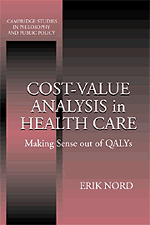Book contents
- Frontmatter
- Contents
- List of Tables and Figures
- Preface and Acknowledgments
- Overview
- Reader's Guide
- 1 Maximizing Value in Health Care
- 2 Three Basic Issues in Economic Evaluation
- 3 QALYs
- 4 Concerns for Fairness
- 5 The Limitations of Utility Measurement
- 6 Ways to Go
- Annex: An Example of Cost-Value Analysis
- References
- Index
3 - QALYs
Published online by Cambridge University Press: 06 July 2010
- Frontmatter
- Contents
- List of Tables and Figures
- Preface and Acknowledgments
- Overview
- Reader's Guide
- 1 Maximizing Value in Health Care
- 2 Three Basic Issues in Economic Evaluation
- 3 QALYs
- 4 Concerns for Fairness
- 5 The Limitations of Utility Measurement
- 6 Ways to Go
- Annex: An Example of Cost-Value Analysis
- References
- Index
Summary
WHAT ARE QALYS?
The QALY is a measure of the value of health outcomes. It was developed in the 1960s and early 1970s with a view to resolving the problem of comparing “apples and oranges” in priority setting in health care (Chiang 1965; Torrance 1970; Culyer et al. 1971). The idea was to refer such different outcomes as saved lives, increases in life expectancy, different kinds of functional improvement, and different kinds of symptom relief to the same value scale, whereby it would be possible to compare these various kinds of outcomes with each other.
One of the key features of the QALY approach is the assessment of the utility of health states. In economic theory, the concept of utility is defined in different ways. Here I shall be very pragmatic. Broadly speaking, the utility of a health state is the same as the “goodness” of it to the individuals who are in it. By goodness I thus mean the wellbeing or quality of life associated with the state. (Note that goodness in an ethical sense is not implied.) The goodness of a state can be measured in a number of ways. In the QALY field there are three main techniques. In two of them – the standard gamble and the time trade-off – one measures individuals' willingness to sacrifice life expectancy in order to be relieved of the symptoms and dysfunctions associated with a state. The greater the willingness to sacrifice to become healthy, the lower is the utility – and the greater the disutility – of the health state in question.
- Type
- Chapter
- Information
- Cost-Value Analysis in Health CareMaking Sense out of QALYS, pp. 18 - 22Publisher: Cambridge University PressPrint publication year: 1999

